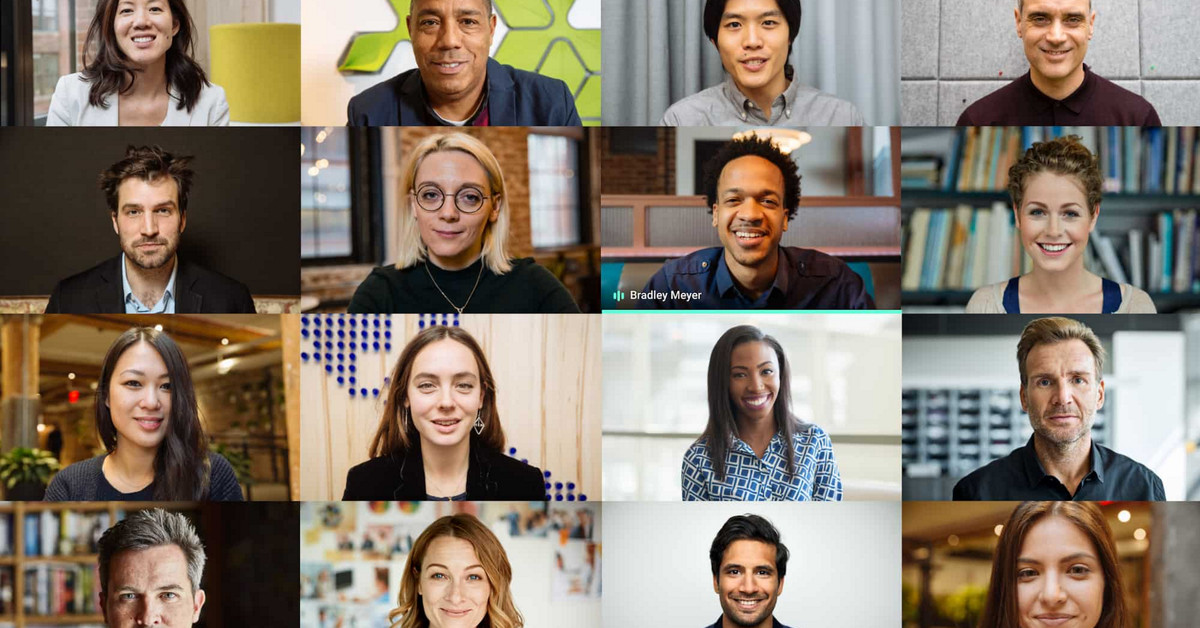There’s a good chance you’ve spent much of the last two-plus years sitting at home, cycling through endless days of virtual meetings staring into your laptop’s webcam and talking into your built-in mic. This means you’ve spent much of the last two-plus years appearing to everyone else like a mushy pile of poorly lit pixels, sounding like you’re shouting from inside a tin can. It’s not your fault: your laptop’s webcam just sucks. And so does its mic. But Google thinks it can fix them both with AI.
Google announced on Wednesday at its annual I/O developer conference that its Workspace team has been working on a couple of AI-powered ways to improve your virtual meetings. The most impressive is Portrait Restore, which Google says can automatically improve and sharpen your image even over a bad connection or through a bad camera. Portrait Lighting, similarly, gives you a set of AI-based controls over how you’re lit. You can’t move the window off to your left, Google seems to be saying, but you can make Google Meet look as if you had one to your right as well. And when it comes to sound, Google’s rolling out a de-reverberation tool meant to minimize the echoes that come from talking into your laptop from a boxy home office.
A lot of the underlying tech here comes from the AI and machine learning work Google has done with its Pixel phones. Those have substantially better hardware to work with than your average laptop webcam, but Prasad Setty, the company’s VP of digital work experience, said the principle is the same. “We want to make sure that the underlying software does the same thing, that we are able to use it across a wide range of hardware devices,” he said.
As hybrid and remote work have grown, the Google Workspace team has spent the last couple of years thinking about how to make work a little easier, Setty said. “We want technology to be an enabler,” Setty said in an interview. “We want it to be helpful, we want it to be intuitive, and we want it to solve real problems.” That led the Workspace team to think more about collaboration — hence the meeting tools — but also about how to make asynchronous work more palatable.
:no_upscale()/cdn.vox-cdn.com/uploads/chorus_asset/file/23453681/Gmail_IO_1024x512.max_1000x1000.png)
Google’s planning to roll out a new tool that generates automatic summaries of Spaces activity, so you can log on in the morning and catch up without having to read hundreds of messages. It’s also launching an automated transcription service for Meet meetings, with plans to eventually also summarize those.
“We want to be able to help people handle this information overload,” Setty said, and use AI to do so. He also said Google’s thinking a lot about “collaboration equity” and “representation equity,” trying to help keep everyone on an equal playing field no matter where they are, what tech they’re using, or how they’re working. One trick for Google, Setty acknowledged, is in helping people without getting too involved, or making employees feel like they’re being watched by either Google or their employer. “The way we think about it,” he said, “is we want to empower users first and foremost. And then give them like the choice of like how they expose that information to their teams, and so on.”
After all this time stuck at home, it’s nice to have a few tools to make your setup work a little better, especially ones that don’t require new apps or gear. But as people go back to the office, Google has an even bigger meeting challenge ahead: solving the problem of the hybrid meeting, with some people in a room and others on a screen. That’s going to take a lot more than good lighting and de-reverb.
